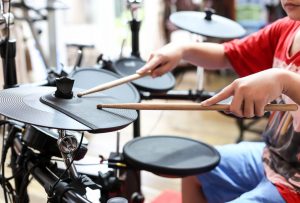When it comes to kids, many studies show a correlation between studying a musical instrument and good results in school. Moreover, playing an instrument involves stimulating areas in the brain that are not normally used in everyday activities. Playing drums involves a complex action of movement coordination and sustained concentration. Moreover, the study of this instrument implies an increased mental discipline. Sometimes learning can be difficult and the only way to get results and progress is through in-depth study and repetition.
Drums are instruments that require coordinated movements of hands, arms and legs and involve both brain hemispheres. Playing drums is far from being easy…

In general, percussion lessons for beginners start with promoting an adequate posture of the body and use of the drum sticks. Then, students will learn their first rhythms. Percussion lessons for the intermediate level include reading at first glance, improving the sound, interpreting middle-level scores and simple exercises for speed and control. Advanced level percussion lessons address those who want to take their technique, speed and rhythm to a professional level.
- Maintain good posture
It is very important for kids to practice good posture when they play, to ensure back and neck protection, preventing discomfort, but also to access easier all of the sections of the drum set. Sometimes, exercises for maintaining good posture must be completed by adjusting the height of the stool, otherwise kids may find it difficult to reach the pedals unless they modify their body posture. Their knees should rest at an angle of about 100 degrees. Find a decent kids drum set to give them the best chance for enjoyment and success.
- Use the drum sticks correctly
Drum sticks must be held properly to prevent strain and play the drums correctly. Kids must grip them between the thumb and index finger, holding them a third of the way up the stick. As they grow and progress, kids may learn other drumstick grips.
- Learn basic notations
Kids are not required to read music before they play drums, but learning basic notation must not be neglected as they start to progress. There are many video instructions and books that cover these basics. Exercises for kids must include identifying musical notes and counting the beat.
- Practice basic rhythms
Kids are typically enthusiastic when they start playing drums but you should temper them and remember them that learning to play drums is not about hitting the instrument at high speed, but rather practicing basic rhythms slowly and accurately. Basic rhythms will teach the kids to move each limb asymmetrically.
If you want to give your kid the chance to become a great drummer, you should get them a good drum set to exercise on. If you do not want to invest a big sum of money on a brand new set that may be soon forgotten if the kid gets bored, you can opt for a child-sized drum set, which is cheaper than regular-sized sets. Alternatively, you can rent a drum set or to purchase a second hand instrument.
And do your best to make those drum exercises as fun and exciting as possible and reward you kid if they stick to the regular practicing routine.
